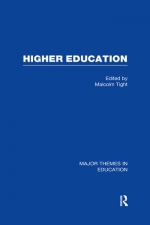Tab Article
The recent, rapid, and massive expansion of higher education in the Western world has been such that in many developed countries it is now expected that close to—or more than—half of the population will have some significant engagement with a university at least once during their lives. More than ever, universities and other institutions of higher education are major businesses; they are seen as key economic drivers by national governments. Moreover, their reach is also increasingly international through their research, knowledge-dissemination, and off-campus teaching activities.
As serious thinking about and around higher education continues to flourish and develop, this new title in Routledge’s Major Themes in Education series meets the need for an authoritative reference work to make sense of the subject’s vast literature and the continuing explosion in research output. Edited by Malcolm Tight, a leading scholar in the field, it is a five-volume collection of foundational and cutting-edge contributions.
The collection is organized into eight principal parts: teaching and learning; course design; the student experience; system policy; institutional management; quality; academic work; and knowledge and research. Close attention is also given to the various methods and theories applied to the study of higher education.
Comprehensive introductions to the collection as a whole, and to each thematic part, which have been newly written by the editor, place the collected material in its historical and intellectual context to make this Routledge Major Work an essential work of reference. It is destined to be valued by specialists in higher education and scholars working in related areas—as well as by educational policy-makers and professionals—as a vital one-stop research tool.


